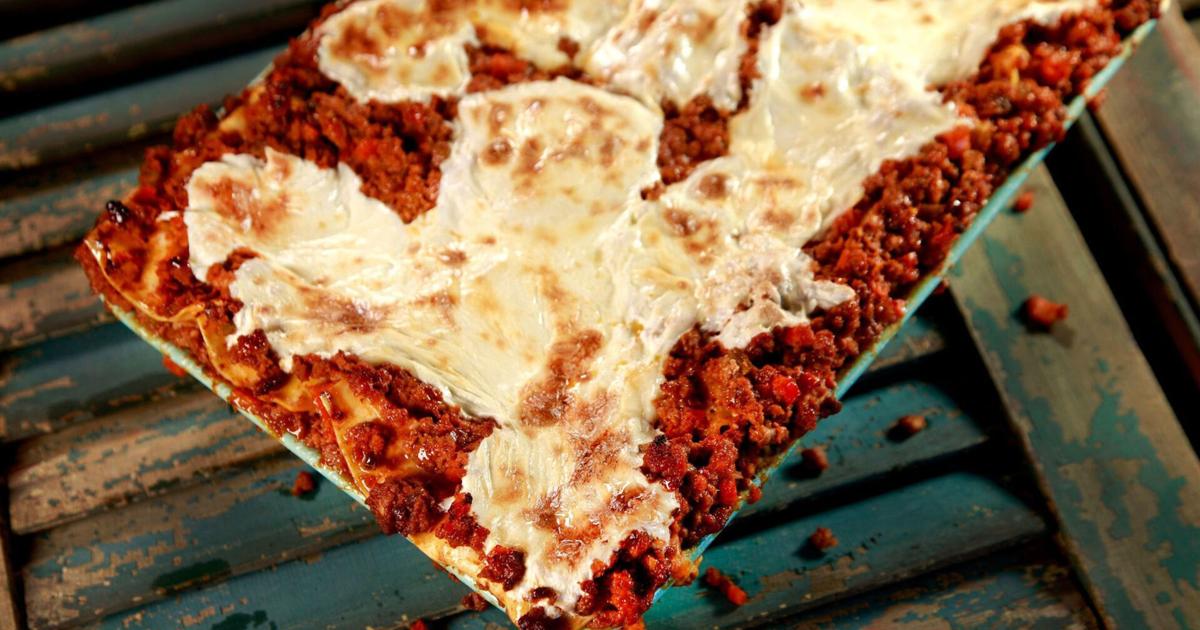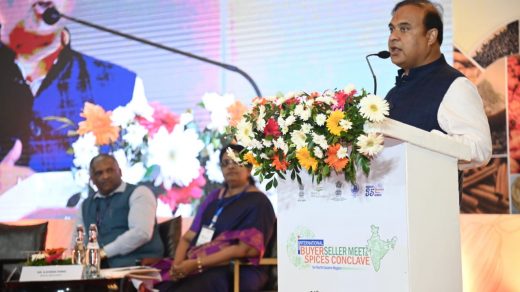Overcast. Low 18F. Winds SSW at 5 to 10 mph..
Overcast. Low 18F. Winds SSW at 5 to 10 mph.
Updated: December 7, 2021 @ 7:15 pm
Lasagna Bolognese recipe from Anthony Bourdain’s “Appetites: A Cookbook.” (Kirk McKoy/Los Angeles Times/TNS)
Lasagna Bolognese recipe from Anthony Bourdain’s “Appetites: A Cookbook.” (Kirk McKoy/Los Angeles Times/TNS)
Five extraordinary lasagna recipes to feed the vegetarians and omnivores at your table
Lasagna is one of those dishes best eaten a day or more after it is made, so the flavors have a chance to marry and the components can bond more firmly. That can be quite helpful at this time of year when we are busy with holiday preparations — and perhaps a bit burned out from all of that Thanksgiving cooking.
A complete meal in itself, no sides are necessary with lasagna, though a green salad can add a welcome crunch factor. Lasagna is easily adaptable for vegetarians and can be made with gluten-free lasagna noodles for those who do not eat wheat. Want to cut down on dishes too? No-boil lasagna noodles reduce preparation time and pot washing.
Classic lasagna Bolognese uses a ragu — slow-cooked meat sauce — rather than ground beef simmered in marinara, and a bechamel in place of the layers of ricotta and mozzarella that we are accustomed to here in America. Though you can’t taste it, Anthony Bourdain’s ragu includes chicken liver, for even more richness and depth of flavor. His Lasagna Bolognese also uses no-boil lasagna noodles for easier assembly.
Lorenza Munoz makes a vegetarian Mexican Lasagna, using popular Mexican ingredients such as rajas — strips of poblano chile sauteed with onions — in place of the meat and her own blend of sour cream and cotija cheese to make “Mexican ricotta.”
Packed with fresh spinach, portobello mushrooms, artichokes and gooey mozzarella, Cafe Roka’s Artichoke and Portobello Mushroom Lasagna is all about a hearty texture. Most people wouldn’t guess it is vegetarian.
Pumpkin Lasagna uses bechamel and a small amount of prosciutto for an almost meatless and “no tomato sauce” take on the dish (read: no long simmering time required). It also calls for Taleggio rather than mozzarella, though any soft, brie-like cheese also works.
And Marion Cunningham prefers pre-cooked lasagna noodles to the no-bake kind for her vegetarian Eggplant Lasagna. The vegetables are diced and cooked in tomato sauce for texture and easy layering, while Cunningham uses cottage cheese in place of the usual ricotta. Spend a few hours making it — or any of these delicious lasagna recipes — and you have many meals worth of heat-and-eat dinners on hand to last throughout the busy holiday season.
———
ANTHONY BOURDAIN’S LASAGNA BOLOGNESE
By Jenn Harris and Anthony Bourdain
Time: 4 hours
Yields: Serves 12 to 16
Unapologetically rich, this lasagna Bolognese is heavy on the bechamel and made with the perfect trinity of pork, veal and beef as well as chicken livers and a lot of cheese. it’s almost too rich, and just perfect when you’re craving a plate of pure comfort blanketed with a layer of melted mozzarella.
Bechamel sauce
6 tablespoons butter
6 tablespoons flour
1 quart milk
Salt and pepper
Pinch freshly ground nutmeg, optional
1. In a medium, heavy-bottom saucepan, heat the butter over medium heat until it foams and subsides. Whisk in the flour and stir it well using a wooden spoon, incorporating it into the butter until a dry paste forms (a roux). Reduce the heat and continue to cook and stir, taking care not to let the mixture brown.
2. Meanwhile, in a large saucepan, bring the milk to a simmer, then gradually whisk it into the pan with the roux, continuing to whisk until the mixture is smooth. Season with 1/2 teaspoon salt and a pinch of pepper, or to taste, along with the nutmeg, if using. Continue to cook over medium-low heat, stirring regularly, until the sauce is thick enough to coat the back of a wooden spoon, about 10 minutes. This makes about 4 cups bechamel.
Lasagne Bolognese
3 tablespoons olive oil, divided
1 large white or yellow onion, finely chopped
2 large or 3 medium carrots, finely chopped
3 ribs celery, finely chopped
4 garlic cloves, finely chopped
1/2 teaspoon fresh thyme leaves
Salt and freshly ground black pepper
1/2 pound chicken livers, trimmed of connective tissue and fat and finely chopped
3/4 pound ground beef chuck
3/4 pound ground veal
3/4 pound ground pork
3/4 cup tomato paste (about 6 ounces)
1 cup Vermentino, Trebbiano or other Tuscan white wine
1 1/2 cups milk
2 bay leaves
About 1 pound dry, flat lasagne noodles
4 cups bechamel sauce
3/4 cup finely grated Parmigiano-Reggiano cheese
6 ounces fresh mozzarella cheese, thinly sliced
1. To make the Bolognese sauce, in a medium, heavy-bottom pot, heat 2 tablespoons oil over medium-high heat. Add the onion, carrots, celery, garlic and thyme and season with 1/2 teaspoon salt and several grinds of pepper, or to taste. Cook, stirring regularly using a wooden spoon, until the vegetables are tender and have released their juices, 7 to 9 minutes. Stir in the livers and cook over high heat for 2 minutes, then add the beef, veal and pork, stirring and breaking up over high heat. Season with 1 teaspoon salt and several grinds pepper, or to taste. Continue to cook over high heat until the meat is brown, stirring regularly and scraping the bottom of the pan as necessary to keep the meat and vegetables from scorching.
2. Once the meat is browned, stir in the tomato paste over medium heat. Cook for about 20 minutes, stirring regularly, to marry the flavors. Add the wine, bring to a boil and cook until the wine is reduced by half, then add the milk and bay leaves and bring to a boil. Reduce the heat to a simmer and cook for 1 1/2 to 2 hours, stirring occasionally. You may need to add a bit of water (or chicken or veal stock, if you have it) to thin the sauce if it thickens too much.
3. Taste the sauce and season with 1 teaspoon salt and several grinds of pepper, or as needed. Remove from heat and stir to release the steam and allow it to cool slightly. Skim the fat off the top with a ladle and discard.
4. Heat the oven to 350 degrees.
5. Coat the inside of a 13-inch by 9-inch (or similar size) baking dish with the remaining tablespoon oil. Cover the bottom of the dish with a layer of bechamel. Sprinkle over some grated cheese, then top with a layer of noodles. top the noodles with a layer of Bolognese sauce, and repeat with the bechamel, grated cheese, noodles, and Bolognese until the pan is filled to the top. The top layer should be Bolognese, dotted with bechamel, with thin slices of mozzarella laid across the top.
6. Place the baking dish on a foil-lined sheet pan and bake in the oven until the lasagna is browned on top and beginning to bubble, about 50 minutes. Remove and set aside to cool. If you must serve it the day you’ve made it, set it aside to rest for 15 minutes before slicing. For best results, allow the lasagna to cool completely and refrigerate overnight. The next day, reheat at 350 degrees, covered loosely with foil, until bubbling. Remove from heat and rest 20 minutes before serving.
Adapted from a recipe in “Appetites: A Cookbook” by Anthony Bourdain.
MEXICAN LASAGNA
Time: 1 hour 20 minutes
Yields: Serves 8 to 12
By Lorenza Munoz
Rajas — peeled and cut poblano strips with sauteed onions — make a terrific taco stuffing, but I also use it as the “meat” for a lasagna. Layer this with noodles and a Mexican version of ricotta (mix sour cream and salty cotija cheese in the food processor to the consistency of cottage cheese). It’s so easy to make and so delicious that it’s now a staple of my dinner parties.
8 poblano chiles
3 tablespoons olive oil, divided
1/2 onion, cut into rounds
1 cup corn kernels
1 chopped garlic clove
1 cup tomato sauce
1 cup vegetable broth
1 (8-ounce) container sour cream
15 ounces (1 1/2 [10-ounce] packages) cotija cheese, divided
9 pieces oven-ready lasagna
6 ounces quesadilla cheese ( 1/2 of a 12-ounce package), shredded
1. Prepare the chiles: Roast the chiles under the broiler or over a stove-top burner until the skin is charred on all sides. Peel the skin and seed the chiles, then cut lengthwise into long strips.
2. Heat the oven to 375 degrees.
3. In a large saute pan, heat 2 tablespoons oil over medium-high heat. Add the onions and cook, stirring frequently, until softened, about 5 minutes. Stir in the corn and chile strips, reduce the heat to low and continue to cook until the corn and chiles are warmed through. Remove from heat and set aside.
4. In a medium saucepan, heat the remaining tablespoon of oil over medium-high heat. Add the garlic and cook until aromatic, about 1 minute. Add the tomato sauce and vegetable broth and heat until hot. Remove from heat and set aside.
5. In a food processor, combine the sour cream with two-thirds of the cotija cheese and blend until creamy but lumpy (this can also be done by hand in a large bowl, using the back of a spoon).
6. Line the base of a 13-by-9-inch baking or casserole dish with 3 lasagna noodles. Add one-half of the corn-chile mixture, distributing evenly over the noodles. Dollop one-half of the sour cream-cotija mixture over the corn and chiles. Place 3 more noodles in the pan, and repeat with the remaining corn-chile mixture and sour cream-cotija mix.
7. Place the 3 remaining noodles in the pan. Sprinkle the shredded quesadilla cheese and remaining cotija cheese over the noodles. Using a spoon, drizzle the thinned tomato sauce evenly over the noodles in the dish.
8. Cover the dish with foil and bake the lasagna for 30 minutes. Remove the foil and continue to bake until the cheese is melted and golden, an additional 10 to 15 minutes.
CAFE ROKA’S ARTICHOKE AND PORTOBELLO MUSHROOM LASAGNA
Time: 2 hours
Yields: Serves 10 to 12
By Noelle Carter
With layers packed with fresh spinach, portobello mushrooms, artichokes and gooey mozzarella, there’s no shortage of creamy richness in this lasagna (and your guests might never guess it’s vegetarian). Assemble the lasagna ahead of time if you wish, then bake before serving; it makes a perfect dinner whether you’re planning for company or a simple family dinner.
2 tablespoons olive oil
1 large onion, medium dice
1 pound portobello mushrooms, medium dice
1 pound coarsely chopped spinach
1/2 cup dry white wine
4 cloves garlic, minced
1 (14-ounce) can artichokes (packed in water), drained and coarsely chopped
Salt and pepper
1/4 cup (1/2 stick) butter
1/4 cup flour
4 1/2 cups milk
1 1/2 cups grated Parmesan cheese
1 (14-ounce) can diced tomatoes, drained
Ground nutmeg
1 (9-ounce) box oven-ready lasagna sheets (no-boil style)
1 pound grated whole milk mozzarella
1. Bring a large pot of water to the boil to blanch the spinach.
2. Meanwhile, heat a large skillet heated over medium-high heat until hot, then add the olive oil and the onion. Cook the onion, stirring frequently, until the onion starts to soften, 3 to 5 minutes. Increase the heat to high, stir in the mushrooms and continue cooking, stirring occasionally, until any of the liquid released from the mushrooms has evaporated, 8 to 10 minutes.
3. While the mushrooms are cooking, blanch the spinach: Add the spinach, in batches, to the boiling water and cook until the spinach softens and turns a bright green, 30 seconds to 1 minute. Transfer the spinach in a large bowl of ice water to stop the cooking. Repeat until all the spinach is blanched. Drain the spinach, and wrap it in a large kitchen towel, squeezing the towel to drain the spinach of any excess moisture.
4. When the liquid from the mushrooms has evaporated, add the white wine, stirring to scrape any flavoring from the bottom of the pan. Add the garlic and artichokes, stirring until completely combined. Taste the mixture, and add three-fourths teaspoon salt and one-half teaspoon pepper, or season as desired. Stir in the spinach, then taste and season again if needed. Remove from heat and set aside.
5. Make the tomato-bechamel sauce: In a medium, heavy-bottom saucepan, melt the butter over medium-high heat. When the butter is foamy, whisk in the flour. Slowly whisk in the milk and cook over medium heat, whisking frequently, until the mixture begins to thicken and take on a sauce-like consistency, 10 to 12 minutes. Slowly stir in the Parmesan cheese, and when the cheese is melted, stir in the tomatoes. Taste the sauce, adding three-fourths teaspoon salt and one-fourth teaspoon pepper, along with a pinch of nutmeg, or season as desired.
6. Heat the oven to 350 degrees and assemble the lasagna: On the bottom of a 13- by 9-inch baking dish, ladle about 1 cup of the tomato-bechamel sauce. Cover the sauce with a single layer of lasagna noodles. Sprinkle one-fourth of the vegetable mixture over the noodles, then ladle over another cup of the sauce. Top the sauce with one-fourth of the grated mozzarella. Repeat with the noodles, vegetables, sauce and mozzarella until you have 4 layers (if you have more than one cup of sauce left when assembling the fourth layer, go ahead and pour all the remaining sauce with that layer before sprinkling over the last of the mozzarella cheese). The dish can be assembled up to this point, covered with plastic wrap and refrigerated up to a day before baking; remove the plastic wrap and leave the lasagna out at room temperature while heating the oven before continuing with the next step.
7. Cover the baking dish with foil and place the dish on a rimmed baking sheet to catch any drippings. Bake the lasagna for 45 minutes. Increase the temperature to 450 degrees, remove the foil from the lasagna and continue baking until the top is lightly browned, 8 to 12 minutes. Remove and cool slightly on a rack for 20 minutes before serving.
Adapted from Cafe Roka in Bisbee, Arizona.
PUMPKIN LASAGNA
Time: 2 hours 30 minutes
Yields: Serves 8 to 10
By Regina Schrambling
This lasagna is a prime example of how well pumpkin works with bechamel and lots of cheese. If you want to double the pumpkin flavor, toss the cut pumpkin with a little pumpkin seed oil before you sauté it. Once pumpkin season ends, you can substitute any other hard squash such as Buttercup, kabocha, Hokkaido, calabaza or even the humble butternut.
1 small pumpkin, about 3 pounds
1 head garlic, outer husk removed, cloves separated
2 tablespoons olive oil
Salt and freshly ground pepper to taste
Pinch cayenne
3 cups milk
1 bay leaf
3 tablespoons butter
3 tablespoons flour
Freshly grated nutmeg to taste
1 cup freshly grated pecorino Romano
1/2 pound fresh lasagna sheets
1/4 pound thinly sliced prosciutto, diced
1/2 pound firm Taleggio, cut or broken into small dice
1. Heat the oven to 350 degrees. Cut the pumpkin in half and scrape out the seeds. Place the pumpkin cut-side down on a baking sheet and bake until soft, 45 minutes to 1 hour. Arrange the garlic cloves in a very small baking dish, add the olive oil and cover with foil. Bake until very soft, about 30 to 35 minutes.
2. When the pumpkin is cooked, drain it cut-side down in a colander, spoon out the meat, then mash it lightly. (It does not have to be smooth, but if it is too stringy, pulse it a few times in a food processor.) Season generously with salt and pepper to taste and a little cayenne. Set aside.
3. When the garlic is cooked, squeeze the pulp out of the skins and set it aside (reserve the oil for another use).
4. Bring a large pot of salted water to a rolling boil to cook the lasagna sheets.
5. Warm the milk in a saucepan with the bay leaf. Melt the butter in a second saucepan over medium heat. Whisk in the flour and cook, whisking, until bubbly and smooth. Discard the bay leaf and whisk in the milk. Cook until thick enough to coat the back of a wooden spoon. Add the garlic, mashing with a spoon to smooth into the sauce. Season with nutmeg, salt and pepper and stir in half the grated pecorino. Keep warm.
6. Cook the lasagna until just al dente, about 1 1/2 to 2 minutes. Drain well.
7. Spread one-quarter (about three-fourths cup) of the white sauce in the bottom of a 7- by 10-inch baking dish. Place a layer of lasagna sheets on top to cover, then spoon on half the pumpkin, spreading to cover completely. Top with another layer of lasagna sheets, one-quarter of the white sauce and all the prosciutto. Place a layer of lasagna sheets on top and arrange the Taleggio bits evenly over it. Top with another layer of lasagna sheets, then with the remaining pumpkin, and finally with a last layer of lasagna sheets, pressing down if necessary to fit into the pan. Spread the remaining white sauce over the top to cover completely. Sprinkle with the remaining pecorino. Place on a baking sheet to catch drips and bake until the top is browned and bubbly, 40 to 45 minutes.
Note: Another brie-like cheese may be substituted for Taleggio.
MARION CUNNINGHAM’S EGGPLANT LASAGNA
Time: 1 hour 20 minutes
Yields: Serves 6
By Marion Cunningham
Lasagna, the wonderful old classic, has become a frequent visitor on my table. It gets such an enthusiastic response when I serve it. My guests tell me it’s because the pasta, always a favorite, shares the limelight with other ingredients, such as vegetables, lots of cheese and sometimes meat, making for an all-inclusive pasta meal.
I have made lasagna with both the “oven-ready” lasagna noodles, which do not need to be cooked in boiling water, and the old-fashioned noodles, which are cooked like other pasta. I found the latter make for a better lasagna. It doesn’t take much time or effort to cook the noodles first before assembling the dish.
Serve this with a small salad.
Eggplant lasagna
1/4 cup olive oil
Salt
9 lasagna noodles
1 (1-pound) eggplant
1 large onion
6 cloves garlic
4 plum tomatoes
2 cups tomato sauce
2 cups large-curd cottage cheese
1 cup grated Parmesan cheese, optional
1. Heat the oven to 350 degrees. Using your fingers, spread a thin layer of olive oil over the bottom of a deep 13×9-inch baking pan and set it aside.
2. Fill a large pot with 4 or 5 quarts of water. Add 2 tablespoons of salt and bring the water to a boil. Add 1 lasagna strip at a time. Gently stir when they are all added so they don’t stick to each other. Turn the heat down a little but keep the water boiling. Cook until the noodles are soft and pliable, 10 minutes. Drain the water and fill the pot with cold water. Use your fingers to move the noodles around so they don’t stick to each other.
3. Slice the stem off the top of the eggplant and discard. Cut the eggplant down the center lengthwise. Cut each half eggplant lengthwise into 3 long slices, then slice the 3 long strips into strips 1 inch wide. Holding the strips together, cut them crosswise into 1-inch cubes. Spread the cubes out and lightly salt them. Set aside.
4. Cut the stem top and root bottom off the onion and peel off the papery skin. Slice the onion from the stem top down, then slice each half into about 4 or 5 slices. Keeping the slices of each half stacked, slice the stack crosswise into about 5 strips. Still holding the cut half onion, chop each half into 1/4-inch to 1/2-inch pieces. Spread the onion pieces out and lightly salt. Set aside.
5. Chop each garlic clove into small pieces and add to the onion. Cut the top core out of each tomato. Slice the tomatoes lengthwise through the center. Place the halves flat side down and cut them into small cubes. Spread them out and lightly salt. Set aside.
6. Put 2 tablespoons of the olive oil in a large skillet. Tilt the skillet so the oil coats the bottom. Turn the heat to medium-high and add the eggplant, onion, garlic and tomatoes. Cook, stirring frequently, until the vegetables are slightly cooked, about 5 minutes. (You may need to do this in 2 batches if your skillet is not large enough.) Add about 1 1/2 cups of the tomato sauce, stir to mix well with the vegetables, and cook just another couple of minutes. Remove from the heat.
7. Place 3 strips of lasagna side by side on the bottom of the baking dish. Spoon a layer of vegetables over the strips. Spread 1 cup of the cottage cheese over the vegetables. Put another 3 strips of lasagna over the first layer and repeat, adding vegetables and cottage cheese. Put the last 3 strips of lasagna over the second layer of filling and stir the remaining olive oil into the remaining 1/2 cup of tomato sauce. Spread this evenly over the lasagna.
8. Bake the lasagna until the eggplant is soft, 40 minutes. Remove from the oven. If using Parmesan cheese, sprinkle it evenly over the top and it will melt immediately. Cut the lasagna into large squares and serve hot.





